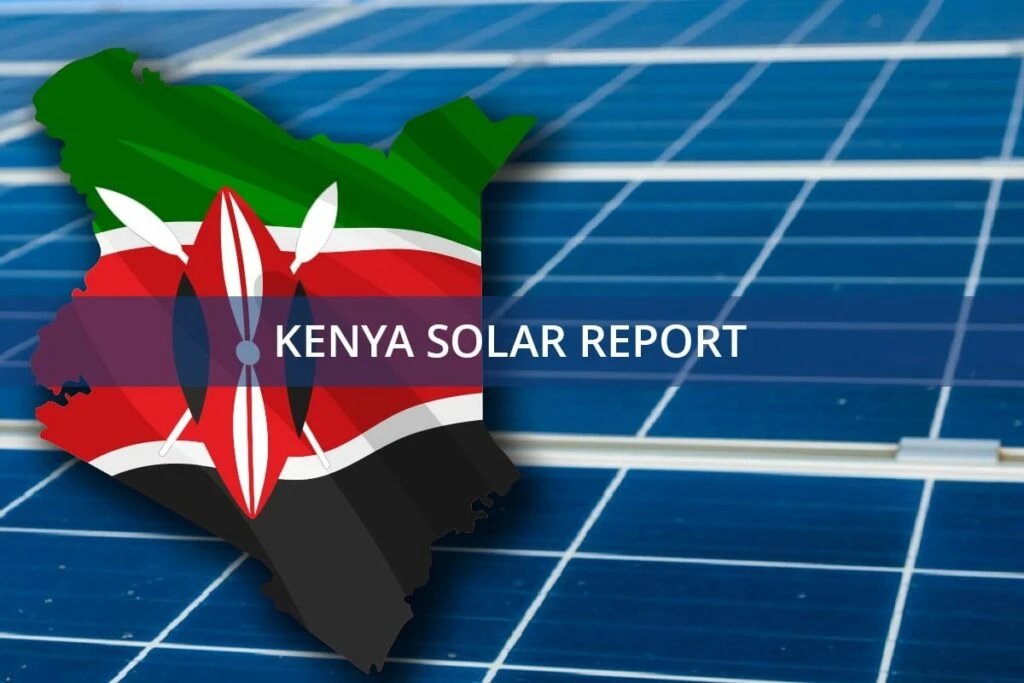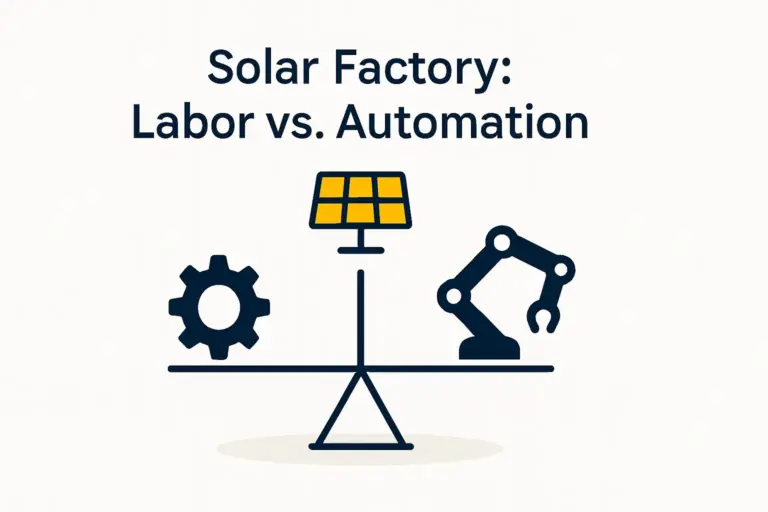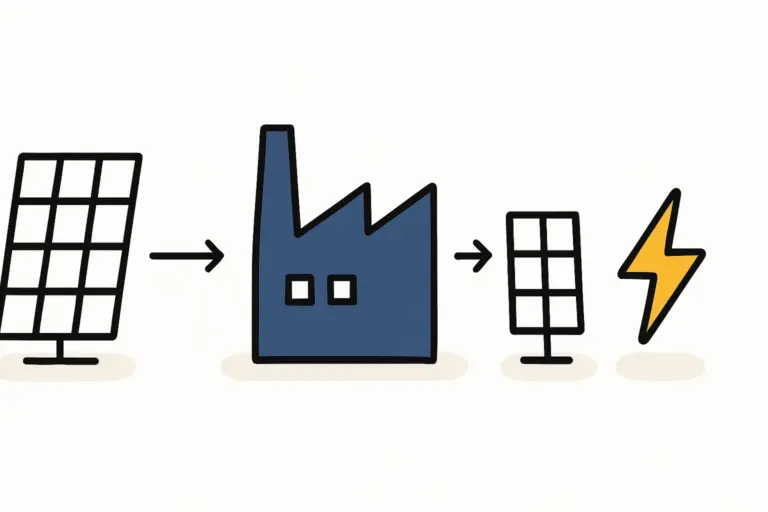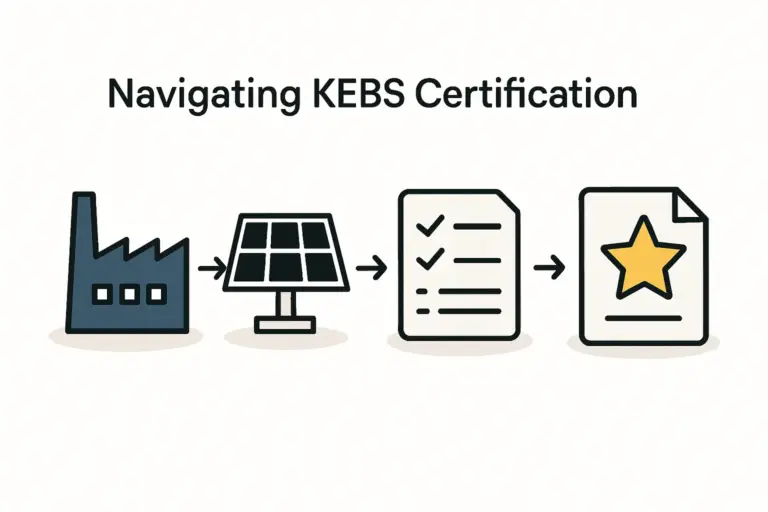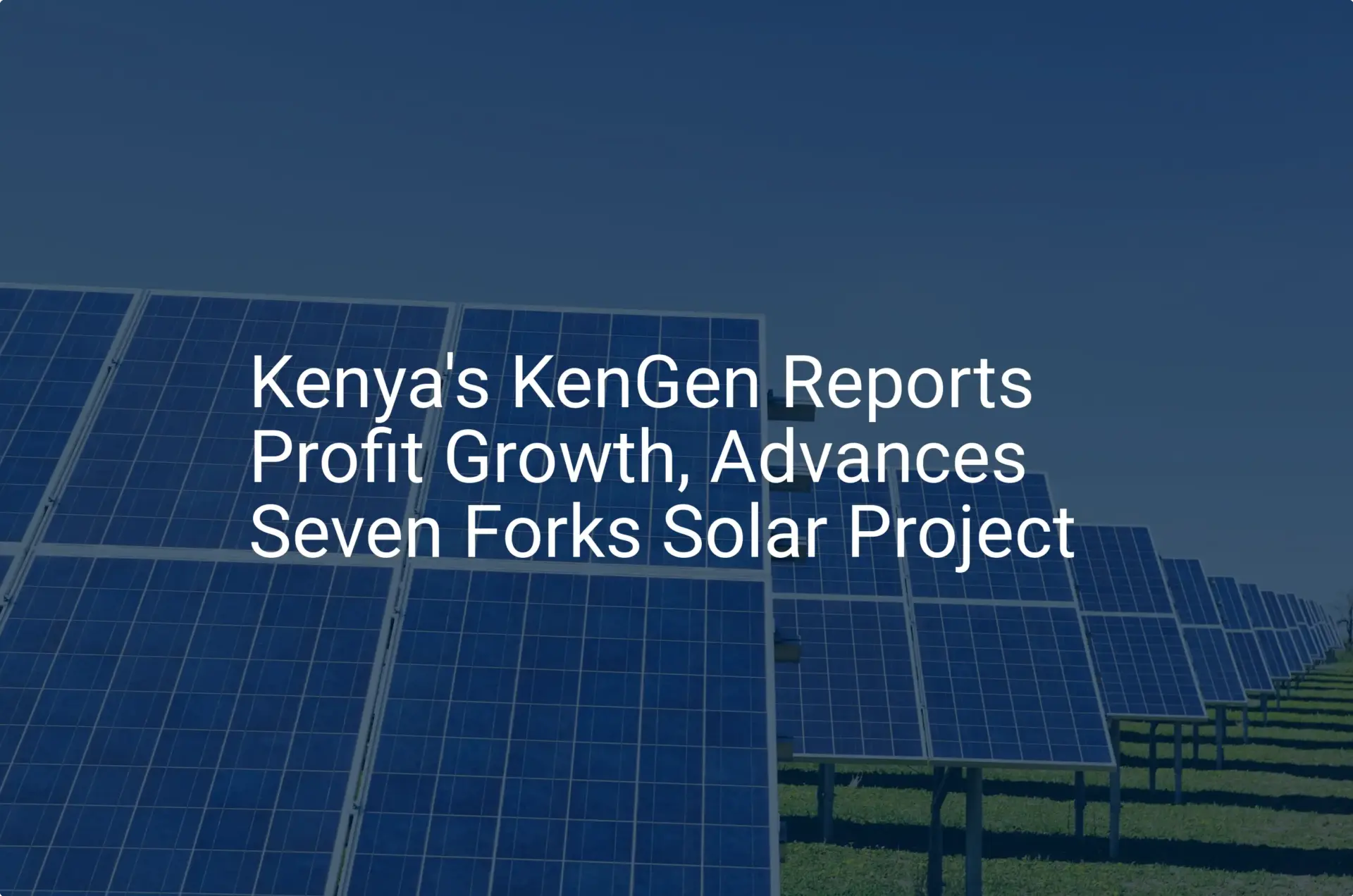For many entrepreneurs entering East Africa’s solar manufacturing sector, maximizing local content is a primary goal. The logic is compelling: sourcing components locally can reduce import dependency, mitigate foreign exchange risks, and potentially lower logistical costs.
This ambition, however, must be weighed against the technical reality of producing a high-quality, bankable solar module that carries a 25-year performance warranty. Investors typically start by examining the Bill of Materials (BOM) and asking a critical question: which components can be realistically procured from within Kenya or the East African Community (EAC)?
This analysis focuses on two of the most frequently considered candidates for localization: aluminum frames and junction boxes.
Understanding the Solar Module Bill of Materials (BOM)
Assessing local sourcing begins with understanding the core components of a modern solar module. The BOM lists every raw material required to assemble a finished panel. While the solar panel manufacturing process involves intricate steps, the primary materials are surprisingly consistent across the industry.
The main components include:
- Solar Cells: The core semiconductor devices that convert sunlight into electricity.
- Tempered Glass: The front protective layer.
- Encapsulant (EVA/POE): Polymer sheets that laminate and protect the cells.
- Backsheet: The rear protective layer, typically a polymer composite.
- Aluminum Frame: Provides structural integrity and a means for mounting.
- Junction Box: An enclosure on the back of the module containing bypass diodes and output cables.
Among these components, solar cells, specialized glass, and encapsulants are high-tech products tied to a complex global supply chain. Any new manufacturing plant in Kenya will invariably have to import them. This naturally turns the focus toward the frame and junction box—components that seem better aligned with existing local industrial capabilities.
The Case for Aluminum Frames: An In-Depth Look at Kenyan Sourcing
The aluminum frame provides rigidity, protects the laminate edges from mechanical stress, and simplifies handling and installation. Its specifications are far more demanding than they first appear.
The Required Specifications for Solar Module Frames
A solar module frame is not just any piece of aluminum. It must meet precise technical requirements to ensure the module’s longevity and safety over several decades in harsh weather conditions.
- Alloy Composition: The industry standard is typically a 6000-series aluminum alloy, such as 6063-T5, which offers an optimal balance of strength, corrosion resistance, and extrudability.
- Profile Precision: The extrusion profile must be manufactured to sub-millimeter tolerances to ensure a perfect fit with the glass-laminate structure. Any deviation can create stress points, leading to microcracks in the cells or delamination over time.
- Anodizing Quality: The frame’s surface is protected by an anodized layer. For solar modules, this layer must be of a specified thickness (e.g., 15 microns or more) to prevent corrosion from humidity, salt mist, or atmospheric pollutants for at least 25 years.
Current Capabilities of Kenyan Aluminum Extruders
Kenya has a well-established aluminum extrusion industry. Companies like ALAF (a subsidiary of the Safal Group) and Mabati Rolling Mills have significant capacity for producing aluminum profiles, though primarily for the construction sector—window frames, door frames, and architectural fittings.
The core challenge lies not in the fundamental capability to extrude aluminum, but in meeting the stringent quality and precision standards of the solar industry.
- Tolerance Mismatch: Tolerances for construction materials are generally wider than those for solar modules. A local supplier would need to prove it can consistently produce profiles to the exact dimensions specified by module designers.
- Anodizing Standards: While local firms offer anodizing services, their processes must be verified to guarantee the layer thickness and uniformity essential for a 25-year outdoor warranty. A substandard anodized layer can lead to cosmetic and, eventually, structural failure of the frame.
- Scale and Consistency: A 50 MW solar module factory consumes a significant volume of aluminum profiles annually. A local supplier must have the capacity to deliver large, consistent batches without variation in quality.

J.v.G. Technology GmbH’s experience setting up turnkey factories globally shows that engaging a local extruder is a viable medium-term goal, but it requires a dedicated supplier development program. A new manufacturer cannot simply place an order; it must work closely with the supplier to calibrate machinery, establish rigorous quality control checkpoints, and conduct extensive testing.
The Business Case: Cost vs. Quality
Sourcing frames locally could lower solar factory investment costs by reducing freight expenses and import duties. These savings, however, must be weighed against the potential risks. A single batch of out-of-spec frames can halt production or, worse, lead to widespread field failures and costly warranty claims, severely damaging a new company’s reputation.
Evaluating Junction Boxes: A More Complex Sourcing Challenge
The junction box is a small but critical component responsible for the module’s electrical safety and output. Its failure can disable the entire panel or even create a fire hazard.
What Defines a High-Quality Junction Box?
A certified, high-quality junction box must meet several criteria:
- High IP Rating: It must have a high Ingress Protection (IP) rating, typically IP67 or IP68, ensuring it is completely sealed against dust and water immersion.
- UV-Resistant Material: The plastic housing must be made from a high-quality, UV-stabilized polymer (like PPO/PPE) that will not become brittle or crack after years of sun exposure.
- Certified Components: The internal bypass diodes, cables, and connectors (e.g., MC4-compatible) must be sourced from reputable manufacturers and certified to international standards (IEC, UL).
The Reality of Local Manufacturing in the EAC
While Kenya and the EAC have a capable plastic injection molding industry that produces a wide range of consumer and industrial goods, producing a high-specification junction box presents a different level of challenge.
The primary obstacle is not molding the plastic housing itself, but the integration and certification of the entire assembly. The bypass diodes, specialty cables, and connectors are highly specialized electronic components that are not manufactured in the region and would need to be imported.
A local enterprise could theoretically import these components and assemble them into a locally molded box. However, this “local assembly” route introduces significant hurdles:
- Quality Control: Establishing a production line with the necessary anti-static controls and testing equipment to assemble electronic components reliably is a complex undertaking.
- Certification: The entire assembled junction box unit would need to undergo expensive and time-consuming international certification processes to be accepted by the market.
For a new module manufacturer, the risk and investment required to develop and certify a locally assembled junction box far outweigh the benefits. Sourcing complete, pre-certified junction boxes from established global suppliers is the most prudent and common approach.

Strategic Recommendations for New Investors
For an entrepreneur establishing a solar module factory in Kenya, a phased approach to localization is the most logical path.
- Phase 1: Prioritize Quality with Imported Components. In the initial years, the primary goal is to produce a high-quality, internationally certified (e.g., IEC 61215) solar module. Using proven, certified components from the global supply chain—including frames and junction boxes—is the most reliable way to achieve this, ensuring product bankability and building market trust.
- Phase 2: Develop Local Frame Suppliers. Once the factory is operational and production is stable, management can begin a supplier development program. This involves identifying the most capable local aluminum extruders and working with them on trial runs, quality control, and testing to eventually transition to a local supply. Outlining this process is a key element of a comprehensive solar manufacturing business plan.
- Phase 3: Re-evaluate Other Components. In the long term, as the regional market and industrial capabilities grow, opportunities for localizing other components, such as junction box assembly or even glass tempering, may become feasible.
Frequently Asked Questions (FAQ)
Can I use aluminum frames from the local construction industry for solar panels?
This is not advisable. Construction frames have different alloy specifications, dimensional tolerances, and anodizing standards that are insufficient for the 25-year lifespan and mechanical stresses expected of a solar module.
What is the main risk of using a substandard junction box?
The primary risks are moisture ingress leading to corrosion and short circuits, bypass diode failure causing power loss, and poor electrical connections creating hot spots, which can become a serious fire hazard. Using a substandard box would also void module certification and warranty.
Does sourcing locally always save money?
Not necessarily in the initial stages. While freight costs may be lower, the investment in supplier development, increased quality control measures, and potentially higher scrap rates can offset these savings. The most significant financial risk comes from field failures and warranty claims from using unproven components.
Are there any components that can be sourced locally in the EAC from day one?
Yes. The most straightforward items to source locally are typically packaging materials, such as cardboard boxes, protective corners, and wooden pallets. These have less impact on the module’s technical performance and are a practical first step in a localization strategy.
Conclusion and Next Steps
While the ambition to create a fully localized solar module supply chain in Kenya is commendable, success depends on a pragmatic, risk-managed approach. For critical components like aluminum frames and junction boxes, the technical and quality requirements make reliance on the established global supply chain essential, at least initially.
The journey should begin by focusing on producing a world-class product using proven materials. This builds a strong foundation of quality and market trust. From that position of strength, a manufacturer can then pursue a strategic, phased localization plan, starting with supplier development for aluminum frames.
This methodical approach balances the desire for local content with the non-negotiable need for quality, reliability, and bankability. Understanding these supply chain nuances is a fundamental part of the planning process. A structured approach is invaluable for guiding an investor through these critical decisions toward a successful and sustainable manufacturing venture.

